
Source:Wang Ying, Qiu Cheng, Zhang Zhixiang. Design and Development of Blood Sugar Regulation Model Based on Micro:bit[J]. Biology Bulletin, 2023, 58(4): 58-60.
To better meet readers’ demands for excellent journal articles, our WeChat public account selectively pushes articles of the current issue. Please stay tuned!
The article “Design and Development of Blood Sugar Regulation Model Based on Micro:bit” published in the 4th issue of 2023 combines open-source software from Micro:bit with knowledge from biology, information technology, and physics to develop a “blood sugar regulation” physical model, achieving a dynamic effect of the blood sugar regulation process and enhancing the interactivity of the model. It is a great interdisciplinary teaching practice article recommended in this issue.
Blood Sugar Regulation Model Based on Micro:bit
Design and Development
Wang Ying Qiu Cheng Zhang Zhixiang
(Ningbo Huizhen Senior High School)
In the teaching of “blood sugar regulation”, physical teaching aids are usually used to concretize abstract problems, helping students understand key points. This study developed a “blood sugar regulation” physical model based on Micro:bit open-source software, integrating knowledge from biology, information technology, and physics to achieve a dynamic effect of the blood sugar regulation process, enhancing the model’s interactivity and helping students deeply understand knowledge related to blood sugar regulation through model construction and dynamic display.
Micro:bit Blood Sugar Regulation Model
Blood sugar regulation is an important content in the high school biology textbook “Homeostasis and Regulation”. This section is microscopically abstract, and the regulatory mechanism is complex, making it difficult for students to understand. Many frontline teachers use cards or small magnets to construct physical models of blood sugar regulation, but they need to manually add or reduce the number of cards to simulate blood sugar changes, resulting in poor dynamic display effects. The “General High School Biology Curriculum Standards (2017 Edition, 2020 Revision)” requires students to “integrate scientific, technological, engineering, and mathematical knowledge and abilities to design solutions to specific problems”. Micro:bit is a microcomputer development board that can achieve functions such as light changes and information display through creative software programming and hardware production. Therefore, the author integrates knowledge from information technology, physics, and biology to develop a “blood sugar regulation” physical model using Micro:bit, simulating the dynamic changes in blood sugar regulation, aiming to clarify the logic of pancreatic cells in blood sugar regulation through interactive methods, deepen conceptual understanding, and fully implement the basic idea of “emphasizing practice in the teaching process”.
Micro:bit, expansion board, soldering station, oscilloscope, glue gun, glue strips, scissors, double-sided tape, several Dupont wires, LED lights, electronic wires, solder wire, transistors, foam board representing the distribution of endocrine glands in the human body, and five foam board components representing tissue cells, muscles, liver, fat cells, and islets.
2.1 Visualization of Phenomena
2.1.1 Visualization of Internal Body Tissues
Using printing technology to obtain a distribution map of endocrine glands in the human body, as well as foam boards representing muscles, liver, tissue cells, fat cells, and islets, the latter five components are cut and pasted at appropriate locations on the distribution map of endocrine glands to highlight the connection between these tissues and the islets by creating a three-dimensional effect.
2.1.2 Visualization of Blood Sugar Concentration
The Micro:bit panel (Figure 1) has 25 built-in LED lights, each light having 8 brightness levels, allowing the panel to represent 200 different states, thus indicating blood sugar concentrations from 0 to 200 units. When the number of lit LED lights is between 10 and 15 (i.e., blood sugar concentration of 80-120 mg/100 mL), it indicates normal blood sugar levels. To visually create the gradual change in blood sugar concentration, the code “control.wait_micros(dtime)” is used, setting dtime to 0.015 s, which means a wait time of 0.015 s is needed for each unit change in brightness.
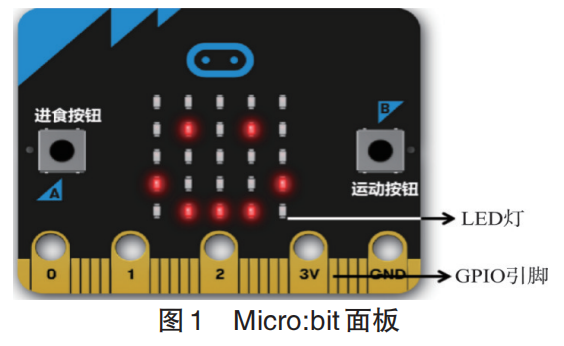
2.1.3 Visualization of Hormonal Action Pathways
Two green Dupont wires (outputs) are drawn from the islet A cells, and five yellow Dupont wires (outputs) are drawn from the islet B cells, with several Dupont wire connectors (inputs) reserved at locations such as muscles, tissue cells, liver, and fat cells. Correctly connecting the Dupont wires can simulate the process of insulin and glucagon being transported through body fluids and acting on the corresponding target organs or cells (Figure 2).
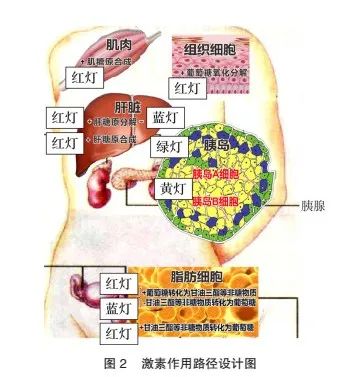
2.1.4 Visualization of Hormonal Effects
Insulin and glucagon have both inhibitory and promoting effects on different blood sugar conversion pathways. For example, insulin can promote the entry of blood sugar into the liver for glycogen synthesis while inhibiting glycogen breakdown. To visualize these effects, two different colored LED lights were placed at locations where promoting and inhibiting effects occur, with red lights indicating promotion and blue lights indicating inhibition. Additionally, green and yellow lights were placed at the islet A and B cells, respectively, indicating increased hormone secretion when lit (Figure 3).
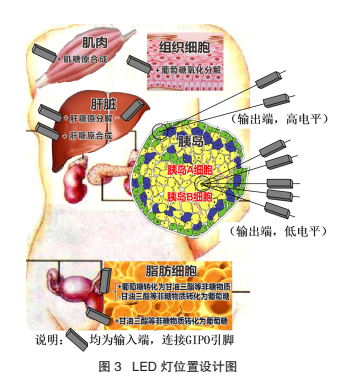
2.2 Simulation of Blood Sugar Changes Induced by Eating or Exercise
The Micro:bit panel has buttons A and B on both sides, with button A set to “simulate eating” and each press lighting up 5 LED lights on the panel. Button B is set to “simulate exercise” and each press extinguishes 5 LED lights.
2.3 Simulation of Hormonal Regulation of Blood Sugar
2.3.1 Circuit Description
The lower end of the Micro:bit panel has several GPIO (general-purpose input/output) pins. Due to the narrow pin positions, an expansion board (Figure 4) is used to connect the Dupont wires. Five Dupont wires (outputs) are drawn from the islet B cell location connected to the 0 V voltage port (low level), and two Dupont wires (outputs) are drawn from the islet A cell location connected to the 5 V voltage port (high level) to distinguish between the two hormones based on the voltage differences for the Micro:bit backend program to make judgments.
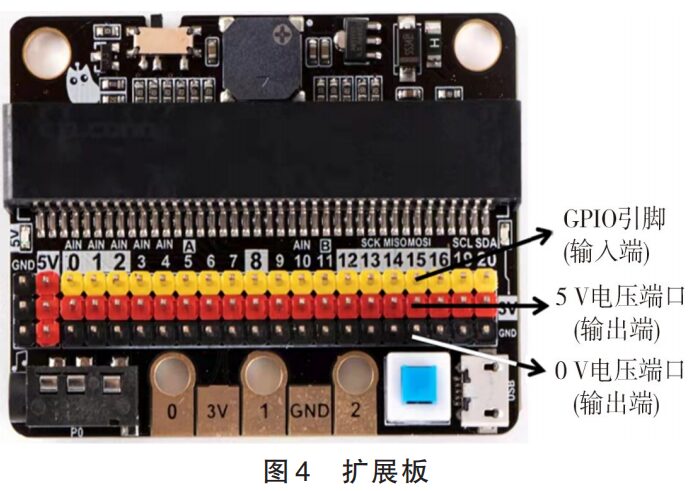
2.3.2 Program Design
When the Dupont wire drawn from the islet B cell location (output, low level) is correctly connected to the Dupont wire drawn from the insulin action pathway (input, GPIO pin), if all GPIO pins receive low levels, the code returns 0, indicating that insulin functions normally. When the program receives “blood sugar rises” information, the corresponding LED lights on the foam board light up, and the number of lit lights on the Micro:bit panel gradually decreases until it returns to normal levels. If there is one or several connection errors, the GPIO pins may receive high levels, and the code returns 1, indicating that insulin function cannot be performed. Similarly, if the Dupont wire drawn from the glucagon action pathway (input, GPIO pin) receives all high levels, the code returns 1, indicating that glucagon functions normally; otherwise, it cannot.
3.1 Demonstration of Insulin Effects
After connecting the power supply, the initial number of lit lights on the Micro:bit panel is 13, indicating an initial blood sugar concentration of 104 mg/100 mL. Pressing the “eat” button causes blood sugar to rise, with each 0.015 s increasing the brightness of 1/8 of the LED lights, quickly increasing to 18 lights. If the Dupont wires in the insulin action part are correctly connected at this point, the Micro:bit receives a signal of “high blood sugar” and starts running the code, lighting up the yellow light at the islet B cell (indicating increased insulin secretion). The LED lights at “promote glycogen synthesis”, “promote glucose oxidation and decomposition”, “promote glycogen synthesis in the liver”, “inhibit glycogen breakdown in the liver”, and “inhibit the conversion of triglycerides and other non-sugar substances into glucose” also light up (indicating that insulin binds to receptors on the surface of target cells and exerts its effects). The number of lit lights on the Micro:bit panel gradually decreases until it returns to normal levels (blood sugar concentration decreases to normal levels), while all LED lights on the foam board extinguish (indicating that insulin secretion has returned to normal).
3.2 Demonstration of Glucagon Effects
Pressing the “exercise” button gradually reduces the number of lit lights on the Micro:bit panel to 8, lowering the blood sugar concentration to 64 mg/100 mL. If the Dupont wires in the glucagon action part are correctly connected at this time, the Micro:bit receives a signal of “low blood sugar” and starts running the code, lighting up the green light at the islet A cell. The LED lights at “promote glycogen breakdown” and “inhibit glucose conversion to triglycerides and other non-sugar substances while promoting the conversion of non-sugar substances to glucose” also light up, causing the number of lit lights on the panel to slowly rise to 10, indicating that the blood sugar concentration reaches 80 mg/200 mL, while all LED lights on the foam board extinguish.
During the teaching process, teachers can guide students to analyze the blood sugar regulation pathways of insulin and glucagon based on data and try to connect the analysis results with the model, that is, connect the Dupont wires (outputs) and Dupont wires (inputs) to test whether the device can operate normally. By observing the operational results, students can immediately determine whether their analysis is correct and make timely corrections and adjustments. They can also gain an intuitive and dynamic understanding of the hormonal regulation of blood sugar through observing the normal operational results, completing the “input” of knowledge while ensuring the interest of the knowledge.
The blood sugar regulation model based on Micro:bit uses biological knowledge as a background, programming the running process of blood sugar regulation and realizing the visualization of microscopic processes through circuit design, covering knowledge from biology, information technology, and physics. Teachers can select students with different disciplinary backgrounds and outstanding abilities to form interest groups before class, and collaborate with the help of a cross-disciplinary teacher team to develop this model, promoting mutual growth in teaching and maximizing the teaching value of this model while effectively enhancing students’ comprehensive practical abilities and developing core competencies across multiple disciplines.
This push only excerpts part of the article, for full reading, please refer to this journal’s 4th issue of 2023. The 2023 edition has been newly revised, welcome to order!

“Biology Bulletin” 2023 4th issue 3D cover
Enter the Taobao APP, scan the QR code below to directly order the 4th issue of 2023, or go to the “Beijing Normal University Publishing Group Flagship Store” and search for “Biology Bulletin” to purchase the 6th issue of 2022 and subsequent issues. Fast delivery, welcome to order!
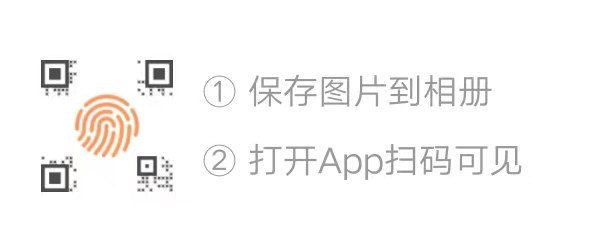
Formatting for this issue: Guo Yufan
Editor for this issue: Zhou Jinjing
Supervisor: China Association for Science and Technology
Organized by: Chinese Zoological Society, Chinese Botanical Society, Beijing Normal University
Published by: Beijing Normal University Publishing Group
Editor: Editorial Department of “Biology Bulletin”
Domestic Unified Publication Number: CN 11-2042/Q
International Standard Publication Number: ISSN 0006-3193
Submission Email: [email protected]
Contact Number: 010-58804350 010-58804739
▌Cooperation Database















